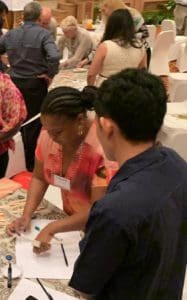When Mediation is a Vocation. Member Spotlight: Cheryl Epps
Cheryl’s kind heart and vocation for helping others are vivid. Before getting fully into mediation, Cheryl dedicated her career to social working, assisting one of the most vulnerable groups in American society: the youngest. She was very passionate about her job, helping children to improve their living conditions and getting through traumatic processes. When she got to know mediation, she really found out where she belongs. Cheryl Epps is currently a retired social worker and a passionate mediator, volunteering under the Los Angeles City Attorney Office. Since 2019, she is engaged as MBBI member, after having enthusiastically taken part in the bi-yearly MBBI International Congress held in Bali, Indonesia.
A Career Engaged With Helping Others
 As a human being marked from an early age by a strong desire to help others, Cheryl graduated at the San Diego State University with Majors in Criminal Justice and Sociology. From the beginning, she was interested in giving her contribution to handling situations where a certain degree of interpersonal conflict could arise. A short period under the Department of Justice as an immigration officer at the US-Mexico border let her ambitions temporally down, as she remained dashed by the way some procedures were handling the situation of immigrants. Nevertheless, as it often happens, it is a twist of fate that makes one discover their real passion. Although her main aspiration was to become a probation officer, her application granted her a position in Child Welfare, and she started working under the Administration for Children & Families.
As a human being marked from an early age by a strong desire to help others, Cheryl graduated at the San Diego State University with Majors in Criminal Justice and Sociology. From the beginning, she was interested in giving her contribution to handling situations where a certain degree of interpersonal conflict could arise. A short period under the Department of Justice as an immigration officer at the US-Mexico border let her ambitions temporally down, as she remained dashed by the way some procedures were handling the situation of immigrants. Nevertheless, as it often happens, it is a twist of fate that makes one discover their real passion. Although her main aspiration was to become a probation officer, her application granted her a position in Child Welfare, and she started working under the Administration for Children & Families.
As she worked for 3 years in a residential facility for abused children, she discovered how rewarding was to support such a vulnerable group of youngsters and to grant them brighter opportunities. As her engagement with social work increased, Cheryl developed another passion, which would turn to be her vocation. By engaging with children’s cases, she started to get confidence in the practice of mediation and to uncover its effectiveness. “Many times, I was informally using mediation techniques in order to figure out with the families what was in the best interest of the child. And naturally, my passion for mediation was exposed along the way”
As a retired social worker, Cheryl is now an officially certified mediator. She dedicates her time to the position of volunteer mediator in the Dispute Resolution task force of the City Attorney Office of Los Angeles. Daily, she deals with a diversity of cases, ranging from neighbors’ disputes to land/tenants’ controversies. ‘Volunteers’ means that she is not getting any salary for her commitment, but Cheryl considers that a gift, considering it an invaluable opportunity to make her community better. “At the end of the day, we are all the same. Humans that have to work together, and we need to engage positively with one another, it is what we are.”
Law Enforcement in the Community: A Challenging
Cheryl recounts that he most demanding mediation she usually engages with is among the Local Police Department and the civil community, where mediation ceases to be purely resolutive and must aim at transforming the relationship between the parties. This is essential to nurture the backbone of coexistence in the community and have a more healing impact. In fact, if in the other cases of civilian disputes, the unsatisfied parties can always address their case to a court, in the mediation between law enforcement officials and civilians, such a process exists only in rare cases. The aim is then to transform the conflict, meaning engaging the parties in shifting their attitudes and perspectives towards more genuine and understanding relationships. Despite being the most desirable, such a goal is rather difficult to achieve, especially if individuals are particularly sedimented in their own beliefs. What Cheryl considers the most difficult obstacle to mediation can be otherwise called ‘Dunning-Kruger’ effect of reason.
 People are so used to see things through their own lenses, growing the conviction of being on the righteous side, to the point they become incapable to see where they are wrong. No compromise with their own belief systems means no openness towards the positions of others. “Certainly, it is a complicated process to set in motion, but when it finally happens, it is extremely satisfying.” Finally, the parties are able to sit around a table to dialogue and to overcome prejudices and pre-existing mindsets on specific happenings in the community. Misunderstandings are more easily solved, actual reasons talked openly, and relationships closely improved. “Law enforcement does not have a good reputation across communities in Los Angeles. But these rounds of mediation engage local communities in authentic conversations which benefit both parties.”
People are so used to see things through their own lenses, growing the conviction of being on the righteous side, to the point they become incapable to see where they are wrong. No compromise with their own belief systems means no openness towards the positions of others. “Certainly, it is a complicated process to set in motion, but when it finally happens, it is extremely satisfying.” Finally, the parties are able to sit around a table to dialogue and to overcome prejudices and pre-existing mindsets on specific happenings in the community. Misunderstandings are more easily solved, actual reasons talked openly, and relationships closely improved. “Law enforcement does not have a good reputation across communities in Los Angeles. But these rounds of mediation engage local communities in authentic conversations which benefit both parties.”
The key to effective conflict resolution? Mediation is a fundamental process to narrow the gaps that might arise among individuals. This happens as mediation has the power to unveil and give space to the real stories, emotions and inner fears of the human beings that engage with it. But for the stories to be effective, the mediator must remain external, restraining themselves from aligning with one or the other party. Impartiality is the first rule for Cheryl. Secondly, showing a calm attitude is tremendously impactful on the mood of the conversation and the behavior of the parties. Calm, second rule. But the most important aspect she is keen to underline is the ability of a mediator to inspire and take out the best from what is at stake in the controversy, uncovering positive and constructive points that people are not able to conceive, often because they are blinded by the above mentioned ‘Danning-Kruger’ effect. “The mediator must be able to show to the parties that a collaborative way forward is possible and beneficial for both. It lies here the secret of our profession.”
The First Engagement with MBBI: The Bali Congress
 Cheryl joined MBBI very recently, just after having found out about the 2019 International Congress of the organization, which took place last November in Bali, Indonesia. Such a recent encounter nevertheless left Cheryl already fascinated by the work of MBBI and by the enthusiasm of its vibrant network of peacebuilders. At first, Cheryl recounts that she was not expecting that mediation would be so largely embraced also by non-Western cultures. What she had the pleasure to experience in Bali is that it actually exists a wide community of mediators from any corner of the globe which are equally committed to building more peaceful and collaborative societies as she is, beyond the cultural differences MBBI gathers a community of passionate personalities dedicated to help others and to bring a remarkable change in their communities, as Cheryl is doing. “At the Bali Congress, I immediately felt this vibe – I discovered a global family of kind-hearted individuals committed to my same purpose.”
Cheryl joined MBBI very recently, just after having found out about the 2019 International Congress of the organization, which took place last November in Bali, Indonesia. Such a recent encounter nevertheless left Cheryl already fascinated by the work of MBBI and by the enthusiasm of its vibrant network of peacebuilders. At first, Cheryl recounts that she was not expecting that mediation would be so largely embraced also by non-Western cultures. What she had the pleasure to experience in Bali is that it actually exists a wide community of mediators from any corner of the globe which are equally committed to building more peaceful and collaborative societies as she is, beyond the cultural differences MBBI gathers a community of passionate personalities dedicated to help others and to bring a remarkable change in their communities, as Cheryl is doing. “At the Bali Congress, I immediately felt this vibe – I discovered a global family of kind-hearted individuals committed to my same purpose.”
Mediation in the time of Coronavirus: A Call for Action
As the last takeaway, Cheryl shares her thoughts regarding how mediation should increasingly engage the society in such a critical moment of emergency like the one the global society is experiencing now due to the outbreak. She thinks that the contribution of mediation would be essential for engaging civil society in a more straightforward, genuine and open conversation with the government. In a situation of extreme chaos, misinformation, and interrogatives, mediation can bring together the perspectives of both sides, maintaining a reliable and clear flow of information in order to raise awareness without mounting panic and lack of trust. “An it happens for civilian cases, or cases between LPDs and civilians, also in the wake of the Coronavirus emergency mediation can make people understand that we can work together, and we have to, in order to go through it.”
Written by Matteo Piovacari: MBBI Writer
